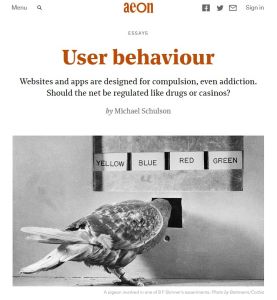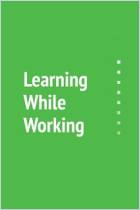
Michael Schulson
User Behaviour
Aeon, 2015
What's inside?
Businesses explicitly design their websites to be addictive. Would regulation help users regain some control?
Recommendation
When a person begins to show signs of Internet addiction, is it only a lack of self-control which is to blame? Freelance science, religion, technology and ethics writer Michael Schulson explains how and why designers craft modern websites to be addictive and explores the ethical implications of companies that profit from “hooking” you in this manner. Schulson also posits practical forms of regulation that might discourage user exploitation. getAbstract recommends this article to those interested in the behavioral sciences and regulation and folks who suspect they’re spending a bit too much time online.
Take-Aways
- Most people today would agree that their Internet usage habits exhibit some, if not many, aspects of addictive or “compulsive” behavior.
- Businesses explicitly design their websites to “hook” people, offering “variable rewards” for continuing to browse and click. This, in turn, develops compulsive Web habits in users.
- Facilitating compulsive web habits is ethically problematic because companies profit from this behavior.
- Some technologies that help users regain control of their Internet behaviors exist, but many people lack awareness of these technologies or the “know-how” to implement them.
- Regulating the tools that Web designers employ to manipulate people would mean expanding users’ “control over their experiences online.”
Summary
While there are no hard and fast diagnostics for Internet addiction, most people today would agree that their Web usage habits exhibit some, if not many, aspects of addictive or “compulsive” behavior. Why is this? Is it simply that people today lack self-control? Not entirely.
Businesses, like Facebook, explicitly design their sites to “hook” users. Web designers use a four-part system designed to keep users browsing and clicking: a “trigger” that starts the user browsing, an “opportunity for action” such as continuing to click or scroll, a “variable reward” in which the user isn’t certain what they will see or find next, and an “investment” such as the chance to comment on or like something.
“Personal responsibility matters. But it’s important to realize that many websites and other digital tools have been engineered specifically to elicit compulsive behavior.”
Understanding website design is one thing, but the fact that sites facilitate compulsive Web habits becomes ethically problematic when you consider how companies benefit from this behavior. Websites appear to offer users what interests them – for example, entertainment or buying options – but in actuality, they lead users beyond their wants for the sake of profit.
“It’s possible to imagine regulation that actually expands users’ choices. It doesn’t need to be especially invasive or dramatic, and it would be designed to give users more control over their experiences online. ”
In the Internet landscape, companies make more money by pushing you through as many virtual “doors” as possible than they do by keeping you engaged with a single piece of content. Slate.com, for instance, doesn’t just want you to open and read a single article; they want you to keep clicking, whether to the next article or on one of their partners’ advertisements.
Some technologies, such as the app Freedom, can help you regain control of your Internet behaviors, but many people lack awareness of these technologies or the “know-how” to implement them. Moreover, expecting companies to self-regulate is naive. But what would external regulation entail? If the goal is to expand users’ “control over their experiences online,” regulatory measures might include allowing people to block notifications and other distracting elements online; banning web design elements which breed compulsive behaviors; forcing companies to “flag” users who are exhibiting signs of Internet addiction; or requiring websites to offer “tools” that would let users track their own behaviors.
About the Author
Michael Schulson is a freelance writer and an associate editor for Religion Dispatches.
This document is restricted to personal use only.
My Highlights
Did you like this summary?
Read the articleThis summary has been shared with you by getAbstract.
We find, rate and summarize relevant knowledge to help people make better decisions in business and in their private lives.
Already a customer? Log in here.


















Comment on this summary